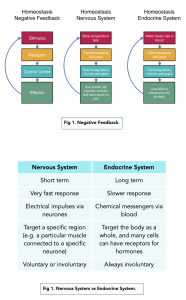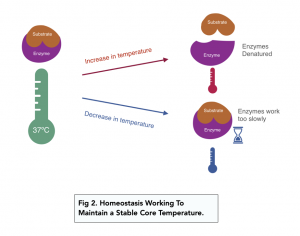Thermoregulation (A-level Biology)
Thermoregulation
Homeostasis
Homeostasis is the maintenance of a constant internal environment.
The internal environment refers to the tissue fluid and blood that surround the cells. Keeping the concentration of fluids in this environment constant is vital to ensure the cells function normally.
This process is vital to:
-
- Protect cells from changes in the external environment.
- Ensure metabolic reactions continue at their optimum rate.
Nervous System vs. Endocrine System
- The endocrine system works with the nervous system to maintain homeostasis
- The endocrine system uses hormones, which are secreted into the bloodstream, and then move through the blood to reach their target organ.

Stable Core Temperature
Importance of Stable Temperature
A stable temperature is important to maintain the optimum rate of metabolic reactions.

- If the internal temperature gets too high (above 40℃), enzymes will begin to denature and the shape of their active site is altered. This decreases the probability of the formation of enzyme-substrate complexes. The increased kinetic energy causes the molecules to vibrate more, breaking the bonds within the enzyme molecule.
- If the internal temperature gets too low, the rate of reaction will slow.
- The optimum temperature in humans is around 37℃.
Thermoregulation refers to the maintenance of a constant internal body temperature in living organisms, despite changes in the surrounding environment.
The normal body temperature for a human is around 37°C (98.6°F).
The two types of thermoregulation are endothermy and ectothermy. Endothermic organisms (like mammals and birds) generate their own heat to maintain a constant body temperature, while ectothermic organisms (like reptiles and fish) rely on external sources of heat to regulate their body temperature.
The three stages of thermoregulation in humans are sensing, processing, and responding. Sensing involves detecting changes in the external environment, processing involves integrating the sensory information and making a decision about how to respond, and responding involves actually carrying out the response (e.g. sweating or shivering).
Physiological responses to heat include sweating, vasodilation (expansion of blood vessels), and increased breathing rate.
Physiological responses to cold include shivering, vasoconstriction (narrowing of blood vessels), and piloerection (raising of body hair).
The hypothalamus is the part of the brain that regulates body temperature. It receives information about the body’s internal and external temperature and coordinates the appropriate responses to maintain a constant temperature.
Fever is a temporary increase in body temperature, usually in response to an infection or illness. The higher temperature helps the body fight off the infection by making it harder for bacteria and viruses to survive.
Hyperthermia is an abnormally high body temperature, typically above 40°C (104°F). It can be caused by prolonged exposure to high temperatures, strenuous physical activity in hot weather, or certain medical conditions.
Hypothermia is an abnormally low body temperature, typically below 35°C (95°F). It can be caused by prolonged exposure to cold temperatures, immersion in cold water, or certain medical conditions.





Still got a question? Leave a comment
Leave a comment